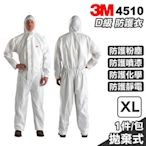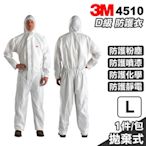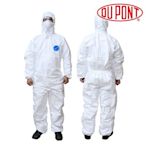搜尋結果
 $236美國杜邦 泰維克 D級 400型 連身式防護衣 -噴漆 烤漆 化學 防護 拋棄式 防護衣 含稅價3M 工業產品
$236美國杜邦 泰維克 D級 400型 連身式防護衣 -噴漆 烤漆 化學 防護 拋棄式 防護衣 含稅價3M 工業產品 $5903M Nexcare 拋棄式防護衣 4510 (白色) (XL號) 1入 (連帽 防塵 防疫)購物中心
$5903M Nexcare 拋棄式防護衣 4510 (白色) (XL號) 1入 (連帽 防塵 防疫)購物中心 $5903M Nexcare 拋棄式防護衣 4510 (白色) (L號) 1入 (連帽 防塵 防疫)購物中心
$5903M Nexcare 拋棄式防護衣 4510 (白色) (L號) 1入 (連帽 防塵 防疫)購物中心 $550《裕章九州》拋棄式隔離衣/防護衣-藍色/白色-10入/包悠淨衛材生活館
$550《裕章九州》拋棄式隔離衣/防護衣-藍色/白色-10入/包悠淨衛材生活館![【歐盟CE認證 貼條款拋棄式 優特達ULTITEC 3000T防護衣】 ✅防疫 ✅搭飛機出差/回國 ✅進出醫院 【歐盟CE認證 貼條款拋棄式 優特達ULTITEC 3000T防護衣】 ✅防疫 ✅搭飛機出差/回國 ✅進出醫院]() $350【歐盟CE認證 貼條款拋棄式 優特達ULTITEC 3000T防護衣】 ✅防疫 ✅搭飛機出差/回國 ✅進出醫院Y7167958596
$350【歐盟CE認證 貼條款拋棄式 優特達ULTITEC 3000T防護衣】 ✅防疫 ✅搭飛機出差/回國 ✅進出醫院Y7167958596![KN95 拋棄式防塵口罩 10個 山田安全防護 3M N95 立體口罩 防護衣 KN95 拋棄式防塵口罩 10個 山田安全防護 3M N95 立體口罩 防護衣]() $800KN95 拋棄式防塵口罩 10個 山田安全防護 3M N95 立體口罩 防護衣山田安全防護
$800KN95 拋棄式防塵口罩 10個 山田安全防護 3M N95 立體口罩 防護衣山田安全防護![【歐盟CE認證 拋棄式 優特達ULTITEC 2000防護衣】 ✅防疫 ✅搭飛機出差/回國 ✅進出醫院 【歐盟CE認證 拋棄式 優特達ULTITEC 2000防護衣】 ✅防疫 ✅搭飛機出差/回國 ✅進出醫院]() $240【歐盟CE認證 拋棄式 優特達ULTITEC 2000防護衣】 ✅防疫 ✅搭飛機出差/回國 ✅進出醫院Y7167958596
$240【歐盟CE認證 拋棄式 優特達ULTITEC 2000防護衣】 ✅防疫 ✅搭飛機出差/回國 ✅進出醫院Y7167958596![杜邦泰維克 D級防護衣 Dupont Tyvek400 拋棄式 頭套連身式 工業防護衣 身體護具 醫碩科技 全館含稅 杜邦泰維克 D級防護衣 Dupont Tyvek400 拋棄式 頭套連身式 工業防護衣 身體護具 醫碩科技 全館含稅]() $295杜邦泰維克 D級防護衣 Dupont Tyvek400 拋棄式 頭套連身式 工業防護衣 身體護具 醫碩科技 全館含稅★醫碩科技★專業工安最佳選擇
$295杜邦泰維克 D級防護衣 Dupont Tyvek400 拋棄式 頭套連身式 工業防護衣 身體護具 醫碩科技 全館含稅★醫碩科技★專業工安最佳選擇![老提莫店-3M 4515 全身透氣型防護衣 (1件) D級防護衣 Tyvek 噴漆 烤漆 化學 防護 雨衣 拋棄式 透氣-效率出貨 老提莫店-3M 4515 全身透氣型防護衣 (1件) D級防護衣 Tyvek 噴漆 烤漆 化學 防護 雨衣 拋棄式 透氣-效率出貨]() $166老提莫店-3M 4515 全身透氣型防護衣 (1件) D級防護衣 Tyvek 噴漆 烤漆 化學 防護 雨衣 拋棄式 透氣-效率出貨老提莫店
$166老提莫店-3M 4515 全身透氣型防護衣 (1件) D級防護衣 Tyvek 噴漆 烤漆 化學 防護 雨衣 拋棄式 透氣-效率出貨老提莫店![杜邦泰維克 D級防護衣 Dupont Tyvek500 頭套連身鬆緊帶式防護衣 拋棄式隔離衣 身體護具 醫碩科技 含稅 杜邦泰維克 D級防護衣 Dupont Tyvek500 頭套連身鬆緊帶式防護衣 拋棄式隔離衣 身體護具 醫碩科技 含稅]() $260杜邦泰維克 D級防護衣 Dupont Tyvek500 頭套連身鬆緊帶式防護衣 拋棄式隔離衣 身體護具 醫碩科技 含稅★醫碩科技★專業工安最佳選擇
$260杜邦泰維克 D級防護衣 Dupont Tyvek500 頭套連身鬆緊帶式防護衣 拋棄式隔離衣 身體護具 醫碩科技 含稅★醫碩科技★專業工安最佳選擇![BioCover亞太醫聯 醫療用衣物-拋棄式防水高筒鞋套(白色)(未滅菌)-1雙/袋 BioCover亞太醫聯 醫療用衣物-拋棄式防水高筒鞋套(白色)(未滅菌)-1雙/袋]() $133BioCover亞太醫聯 醫療用衣物-拋棄式防水高筒鞋套(白色)(未滅菌)-1雙/袋購物中心
$133BioCover亞太醫聯 醫療用衣物-拋棄式防水高筒鞋套(白色)(未滅菌)-1雙/袋購物中心![BioCover亞太醫聯 醫療用衣物-拋棄式連身型隔離衣(未滅菌)(M號)-1件/袋 BioCover亞太醫聯 醫療用衣物-拋棄式連身型隔離衣(未滅菌)(M號)-1件/袋]() $349BioCover亞太醫聯 醫療用衣物-拋棄式連身型隔離衣(未滅菌)(M號)-1件/袋購物中心
$349BioCover亞太醫聯 醫療用衣物-拋棄式連身型隔離衣(未滅菌)(M號)-1件/袋購物中心
Per- and polyfluoroalkyl substances are defined as a group of synthetic organofluorine chemical compounds that have multiple fluorine atoms attached to an alkyl chain. An early definition, from 2011, required that they contain at least one perfluoroalkyl moiety, –C n F 2n+1 –. [13] [14] Beginning in 2021, the Organisation for Economic Co ...
The Chernobyl disaster [a] began on 26 April 1986 with the explosion of the No. 4 reactor of the Chernobyl Nuclear Power Plant near the city of Pripyat in the north of the Ukrainian SSR, close to the border with the Byelorussian SSR, in the Soviet Union. [1] It is one of only two nuclear energy accidents rated at seven—the maximum severity ...
- Reactor design and operator error
- INES Level 7 (major accident)
- 26 April 1986; 37 years ago
- History
- Production
- Properties
- Processing
- Applications and Uses
- Safety
- Ecotoxicity
- Similar Polymers
- See Also
- Further Reading
Polytetrafluoroethylene (PTFE) was accidentally discovered in 1938 by Roy J. Plunkett while he was working in New Jersey for DuPont. As Plunkett attempted to make a new chlorofluorocarbon refrigerant, the tetrafluoroethylene gas in its pressure bottle stopped flowing before the bottle's weight had dropped to the point signaling "empty". Since Plunk...
PTFE is produced by free-radical polymerization of tetrafluoroethylene.The net equation is 1. n F2C=CF2 → −(F2C−CF2)n− Because tetrafluoroethylene can explosively decompose to tetrafluoromethane (CF4) and carbon, a special apparatus is required for the polymerization to prevent hot spots that might initiate this dangerous side reaction. The process...
PTFE is a thermoplastic polymer, which is a white solid at room temperature, with a density of about 2200 kg/m3 and a melting point of 600 K (327 °C; 620 °F). It maintains high strength, toughness and self-lubrication at low temperatures down to 5 K (−268.15 °C; −450.67 °F), and good flexibility at temperatures above 194 K (−79 °C; −110 °F). PTFE g...
Processing PTFE can be difficult and expensive, because the high melting temperature, 327 °C (621 °F), is above the decomposition temperature. Even when molten, PTFE does not flow due to its exceedingly high melt-viscosity. The viscosity and melting point can be decreased by inclusion of small amount of comonomers such as perfluoro (propylvinyl eth...
Wire insulation, electronics
The major application of PTFE, consuming about 50% of production, is for the insulation of wiring in aerospace and computer applications (e.g. hookup wire, coaxial cables). This application exploits the fact that PTFE has excellent dielectric properties, specifically low group velocity dispersion, especially at high radio frequencies, making it suitable for use as an excellent insulator in connector assemblies and cables, and in printed circuit boards used at microwave frequencies. Combined w...
Bearings seals
In industrial applications, owing to its low friction, PTFE is used for plain bearings, gears, slide plates, seals, gaskets, bushings, and more applications with sliding action of parts, where it outperforms acetal and nylon.
Electrets
Its extremely high bulk resistivity makes it an ideal material for fabricating long-life electrets, the electrostatic analogues of permanent magnets.
While PTFE is stable at lower temperatures, it begins to deteriorate at temperatures of about 260 °C (500 °F), it decomposes above 350 °C (662 °F), and pyrolysis occurs at temperatures above 400 °C (752 °F). The main decomposition products are fluorocarbon gases and a sublimate, including tetrafluoroethylene (TFE) and difluorocarbene radicals(RCF2)...
Trifluoroacetate
Sodium trifluoroacetate and the similar compound sodium chlorodifluoroacetate can both be generated when PTFE undergoes thermolysis, as well as producing longer chain polyfluoro- and/or polychlorofluoro- (C3-C14) carboxylic acids which may be equally persistent. These products can accumulate in evaporative wetlandsand have been found in the roots and seeds of wetland plant species, but has not been observed to have an adverse impact on plant health or germination success.
PFOA
Perfluorooctanoic acid (PFOA, or C8) has been used as a surfactant in the emulsion polymerizationof PTFE, although several manufacturers have entirely discontinued its use. PFOA persists indefinitely in the environment. PFOA has been detected in the blood of many individuals of the general US population in the low and sub-parts per billion range, and levels are higher in chemical plant employees and surrounding subpopulations. PFOA and perfluorooctanesulfonic acid (PFOS) have been estimated t...
GenX
As a result of the lawsuits concerning the PFOA class-action lawsuit, DuPont began to use GenX, a similarly fluorinated compound, as a replacement for perfluorooctanoic acid in the manufacture of fluoropolymers, such as Teflon-brand PTFE.However, in lab tests on rats, GenX has been shown to cause many of the same health problems as PFOA. The chemicals are manufactured by Chemours, a corporate spin-off of DuPont, in Fayetteville, North Carolina. Fayetteville Works was the site where DuPont beg...
The Teflon trade name is also used for other polymers with similar compositions: 1. Perfluoroalkoxy alkane(PFA) 2. Fluorinated ethylene propylene(FEP) These retain the useful PTFE properties of low friction and nonreactivity, but are also more easily formable. For example, FEP is softer than PTFE and melts at 533 K (260 °C; 500 °F); it is also high...
Ellis, D.A.; Mabury, S.A.; Martin, J.W.; Muir, D.C.G.; Mabury, S.A.; Martin, J.W.; Muir, D.C.G. (2001). "Thermolysis of fluoropolymers as a potential source of halogenated organic acids in the envi...
Formaldehyde ( / fɔːrˈmældɪhaɪd / ⓘ for-MAL-di-hide, US also / fər -/ ⓘ fər-) ( systematic name methanal) is an organic compound with the chemical formula CH2O and structure H−CHO, more precisely H2C=O. The compound is a pungent, colourless gas that polymerises spontaneously into paraformaldehyde.
Supermarine Spitfire. The Supermarine Spitfire is a British single-seat fighter aircraft used by the Royal Air Force and other Allied countries before, during, and after World War II. It was the only British fighter produced continuously throughout the war. The Spitfire remains popular among enthusiasts.
Sigmund Freud (/ f r ɔɪ d / FROYD, German: [ˈziːkmʊnt ˈfrɔʏt]; born Sigismund Schlomo Freud; 6 May 1856 – 23 September 1939) was an Austrian neurologist and the founder of psychoanalysis, a clinical method for evaluating and treating pathologies seen as originating from conflicts in the psyche, through dialogue between patient and psychoanalyst, and the distinctive theory of mind and ...
Green politics. Environment friendly processes, or environmental-friendly processes (also referred to as eco-friendly, nature-friendly, and green ), are sustainability and marketing terms referring to goods and services, laws, guidelines and policies that claim reduced, minimal, or no harm upon ecosystems or the environment. [1]








